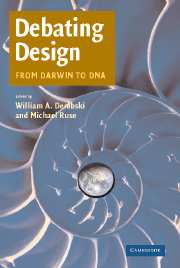Book contents
- Frontmatter
- Contents
- Notes on Contributors
- Debating Design
- INTRODUCTION
- PART I DARWINISM
- PART II COMPLEX SELF-ORGANIZATION
- PART III THEISTIC EVOLUTION
- PART IV INTELLIGENT DESIGN
- 17 The Logical Underpinnings of Intelligent Design
- 18 Information, Entropy, and the Origin of Life
- 19 Irreducible Complexity
- 20 The Cambrian Information Explosion
- Index
- References
19 - Irreducible Complexity
Obstacle to Darwinian Evolution
Published online by Cambridge University Press: 05 June 2012
- Frontmatter
- Contents
- Notes on Contributors
- Debating Design
- INTRODUCTION
- PART I DARWINISM
- PART II COMPLEX SELF-ORGANIZATION
- PART III THEISTIC EVOLUTION
- PART IV INTELLIGENT DESIGN
- 17 The Logical Underpinnings of Intelligent Design
- 18 Information, Entropy, and the Origin of Life
- 19 Irreducible Complexity
- 20 The Cambrian Information Explosion
- Index
- References
Summary
A SKETCH OF THE INTELLIGENT DESIGN HYPOTHESIS
In his seminal work On the Origin of Species, Darwin hoped to explain what no one had been able to explain before – how the variety and complexity of the living world might have been produced by simple natural laws. His idea for doing so was, of course, the theory of evolution by natural selection. In a nutshell, Darwin saw that there was variety in all species. For example, some members of a species are bigger than others, some faster, some brighter in color. He knew that not all organisms that are born will survive to reproduce, simply because there is not enough food to sustain them all. So Darwin reasoned that the ones whose chance variation gives them an edge in the struggle for life would tend to survive and leave offspring. If the variation could be inherited, then over time the characteristics of the species would change, and over great periods of time, perhaps great changes could occur.
It was an elegant idea, and many scientists of the time quickly saw that it could explain many things about biology. However, there remained an important reason for reserving judgment about whether it could actually account for all of biology: the basis of life was as yet unknown. In Darwin's day, atoms and molecules were still theoretical constructs – no one was sure if such things actually existed.
- Type
- Chapter
- Information
- Debating DesignFrom Darwin to DNA, pp. 352 - 370Publisher: Cambridge University PressPrint publication year: 2004
References
- 9
- Cited by

